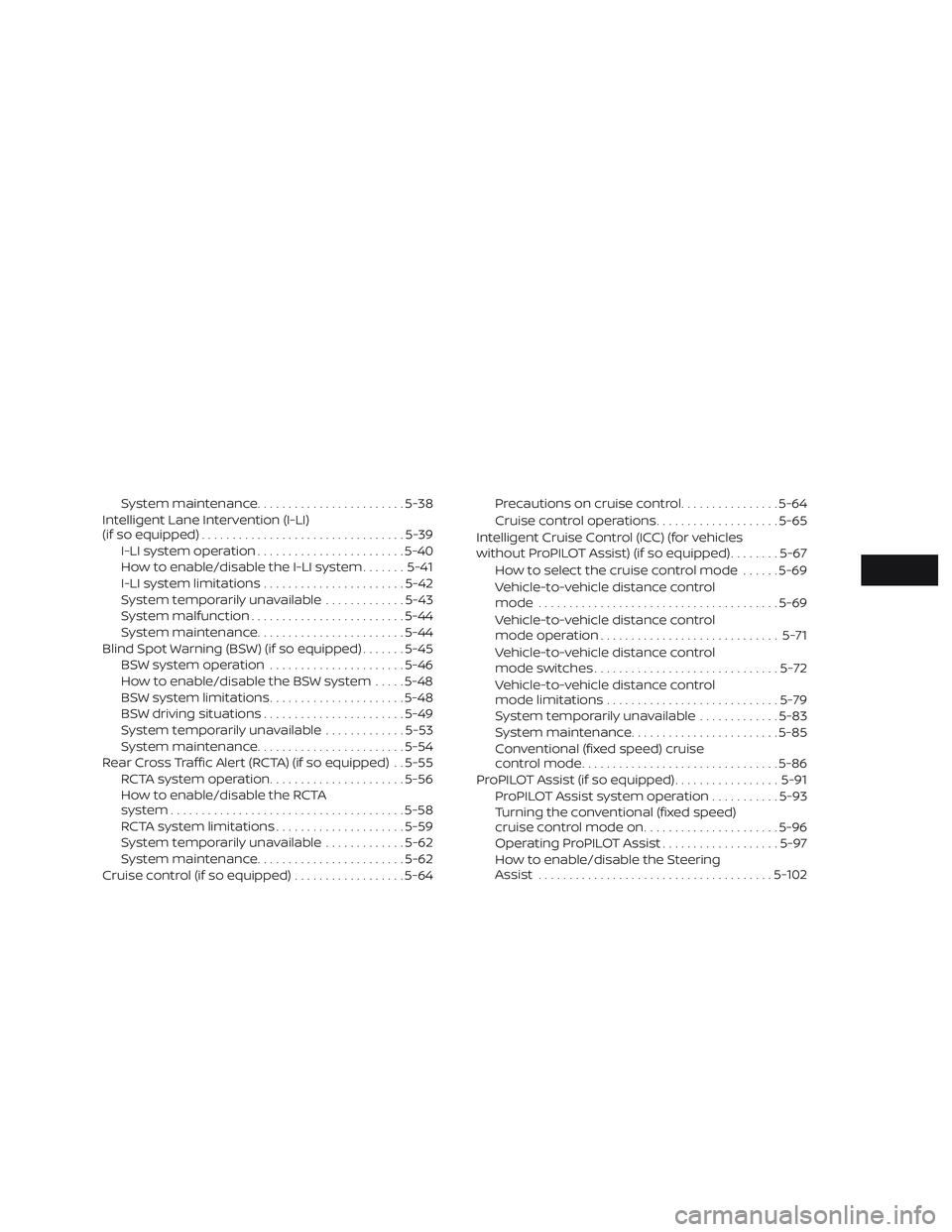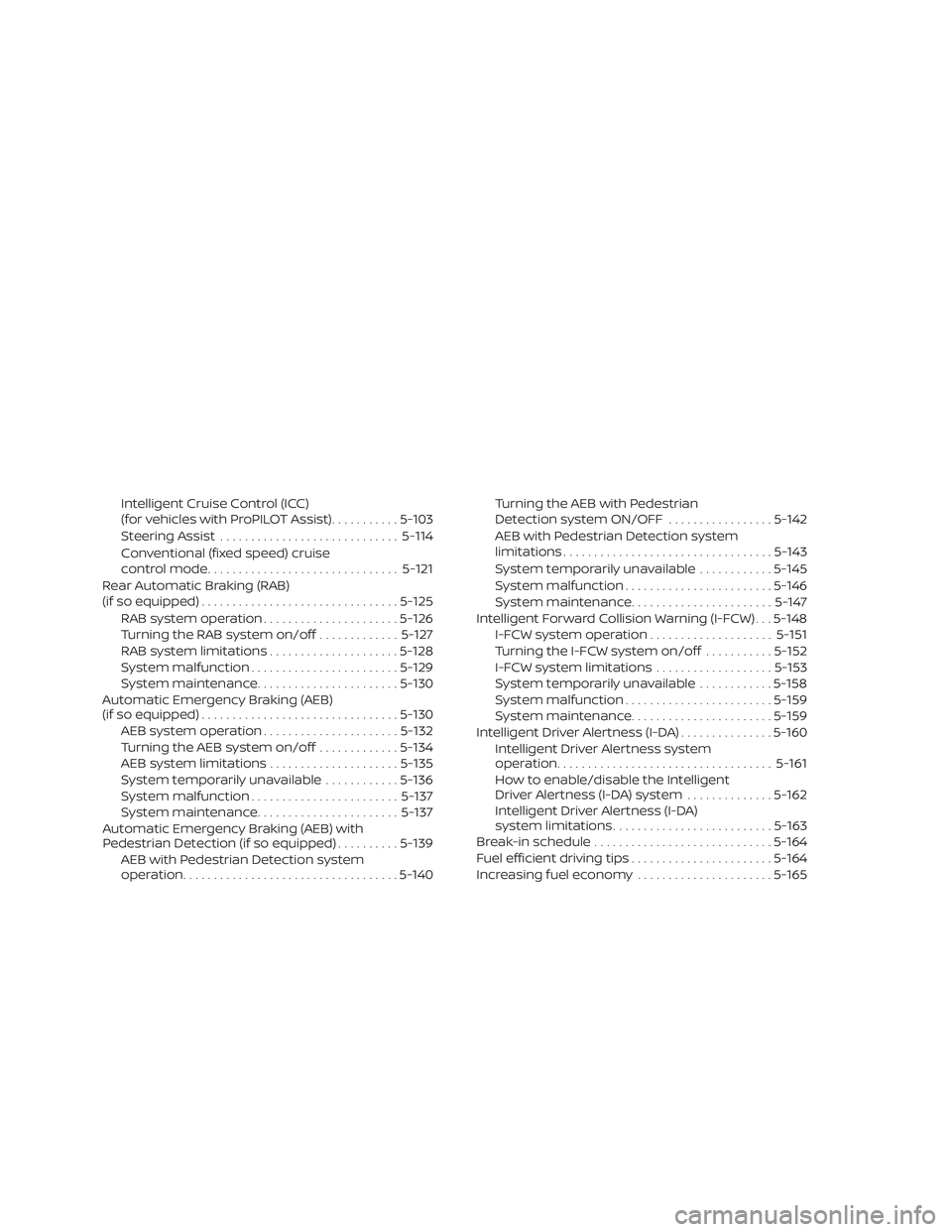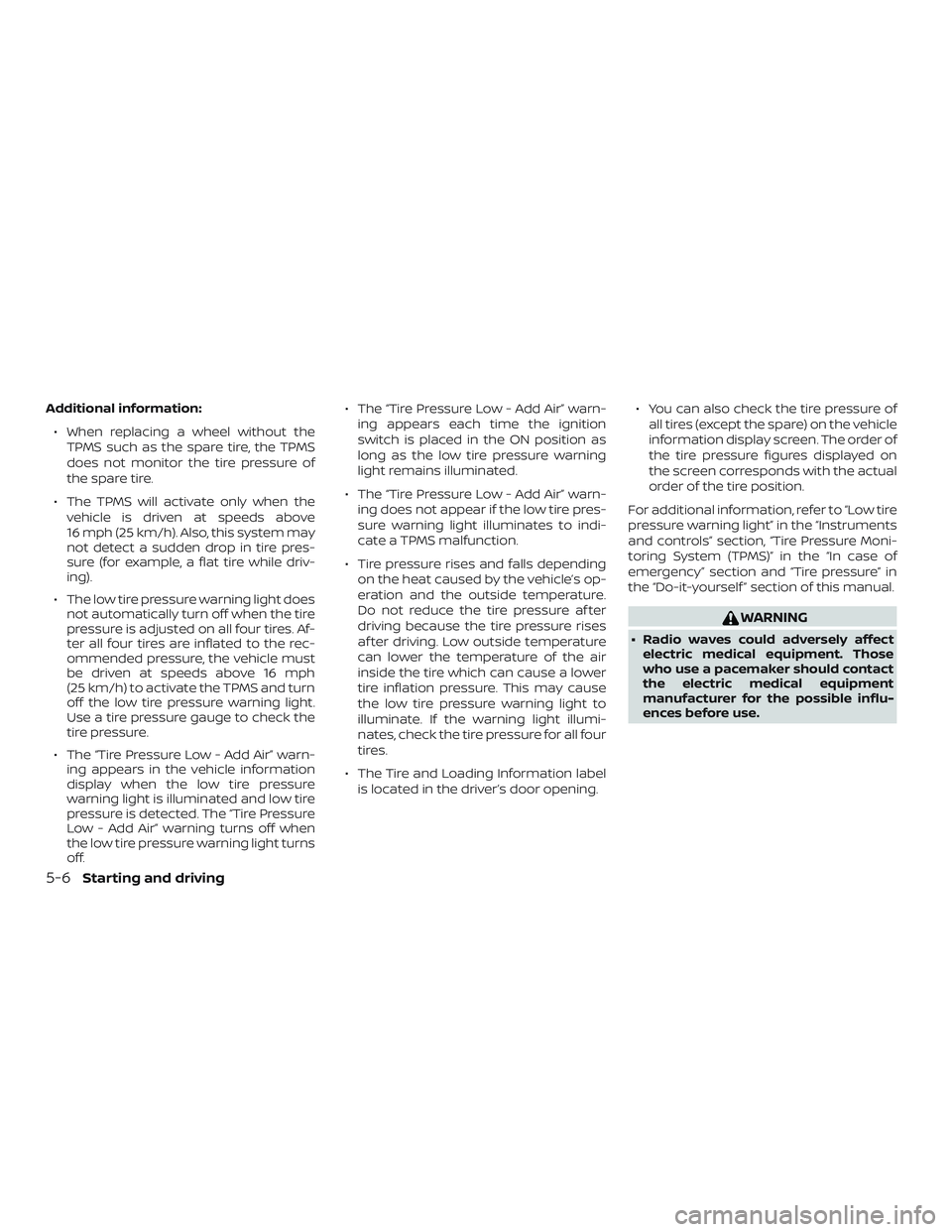2019 NISSAN ALTIMA Malfunction
[x] Cancel search: MalfunctionPage 247 of 592

∙ Af ter parking in the sun, drive for 2 or3 minutes with the windows open to
vent hot air from the passenger com-
partment. Then, close the windows.
This allows the air conditioner to cool
the interior more quickly.
∙ The air conditioning system should be operated for approximately 10 minutes
at least once a month. This helps pre-
vent damage to the system due to lack
of lubrication.
∙ A visible mist may be seen coming from the ventilators in hot, humid conditions
as the air is cooled rapidly. This does not
indicate a malfunction.
∙ If the engine coolant temperature gauge indicates engine coolant tem-
perature over the normal range, turn
the air conditioner off. For additional in-
formation, refer to “If your vehicle over-
heats” in the “In case of emergency”
section of this manual.
∙ When Remote Engine Start (if so equipped) is activated, the manual cli-
mate control system will default to the
last used heating or cooling mode.AIR FLOW CHARTS
The following charts show the button and
dial positions for MAXIMUM AND QUICK
heating, cooling or defrosting. The
air
recirculation button should always be in
the off position for heating and defrost-
ing.
Monitor, climate, audio, phone and voice recognition systems4-33
Page 252 of 592

Start the engine and operate the controls
to activate the air conditioner.
NOTE:∙ Odors from inside and outside the ve-
hicle can build up in the air condi-
tioner unit. Odor can enter the pas-
senger compartment through the
vents.
∙ When parking, set the heater and air
conditioner controls to turn off air re-
circulation to allow fresh air into the
passenger compartment. This should
help reduce odors inside the vehicle.
AUTOMATIC OPERATION
Cooling and/or dehumidified
heating (AUTO)
This mode may be used all year round as
the system automatically works to keep a
constant temperature. Air flow distribution,
air intake control, and fan speed are also
controlled automatically.
1. Press the AUTO button on.
2. Turn the temperature control dial to the lef t or right to set the desired tem-
perature. ∙ Adjust the temperature display to
about 75°F (24°C) for normal operation.
∙ The temperature of the passenger compartment will be maintained auto-
matically. Air flow distribution, air intake
control and fan speed are also con-
trolled automatically.
∙ A visible mist may be seen coming from the vents in hot, humid conditions as
the air is cooled rapidly. This does not
indicate a malfunction.
3. You can individually set driver’s and front passenger’s side temperature us-
ing each temperature control dial. To
synchronize the driver’s and front pas-
senger’s temperature settings, press
the SYNC button.
Heating (A/C OFF)
The air conditioner does not activate. When
you need to heat only, use this mode.
1. Press the AUTO button.
2. Turn the temperature control dial to set the desired temperature.
∙ The temperature of the passenger compartment will be maintained auto-
matically. Air flow distribution and fan
speed are also controlled automatically. ∙ Do not set the temperature lower than
the outside air temperature. Otherwise,
the system may not work properly.
∙ Not recommended if windows fog up.
Dehumidified defrosting or
defogging
1. Press thefront defroster button
on.
2. Turn the temperature control dial to set the desired temperature.
∙ To quickly remove ice from the outside of the windows, use the
fan speed
control buttons to set the fan speed to
maximum.
∙ As soon as possible af ter the wind- shield is clean, press the AUTO button to
return to the automatic mode.
∙ When the
front defroster button is
pressed, the air conditioner will auto-
matically be turned on at outside tem-
peratures above 36°F (2°C). The air recir-
culate mode automatically turns off,
allowing outside air to be drawn into the
passenger compartment to further im-
prove the defogging performance.
4-38Monitor, climate, audio, phone and voice recognition systems
Page 255 of 592

∙ When the climate system is in auto-matic operation and the engine coolant
temperature and outside air tempera-
ture are low, the air flow outlet may de-
fault to defroster mode for a maximum
of 2 minutes 30 seconds. This is not a
malfunction. Af ter the engine coolant
temperature warms up, the air flow out-
let will return to foot mode and opera-
tion will continue normally.
∙ When the outside and interior cabin temperatures are moderate to high, the
intake setting may default to turn off air
recirculation to allow fresh air into the
passenger compartment. You may no-
tice air flow from the foot mode, bi-level
mode, or side demist vent outlets for a
maximum of 15 seconds. This may oc-
cur when the previous climate setting
was turned off. This is not a malfunction.
Af ter the initial warm air is expelled, the
intake will return to automatic control,
the air flow outlet will return to previous
settings, and operation will continue
normally. To exit, press any climate con-
trol button. ∙ Keep the moonroof (if so equipped)
closed while the air conditioner is in op-
eration.
∙ If you feel that the air flow mode you have selected and the outlets the air is
coming out do not match, select
the
mode.
∙ When you change the air flow mode, you may feel air flow from the foot out-
lets for just a moment. This is not a
malfunction. The air conditioner system in your NISSAN
vehicle is charged with a refrigerant de-
signed with the environment in mind.
This refrigerant does not harm the
earth’s ozone layer.
Special charging equipment and lubricant
is required when servicing your NISSAN air
conditioner. Using improper refrigerants or
lubricants will cause severe damage to
your air conditioner system. For additional
information, refer to “Air conditioner sys-
tem refrigerant and oil recommendations”
in the “Technical and consumer informa-
tion” section of this manual.
It is recommended that you visit a NISSAN
dealer to service your “environmentally
friendly” air conditioner system.
WARNING
The air conditioner system contains re-
frigerant under high pressure. To avoid
personal injury, any air conditioner ser-
vice should be done only by an experi-
enced technician with proper equipment.
SERVICING AIR CONDITIONER
Monitor, climate, audio, phone and voice recognition systems4-41
Page 258 of 592

5 Starting and driving
Precautions when starting and driving..........5-4
Exhaust gas (carbon monoxide) ..............5-4
Three-way catalyst ...........................5-4
Tire Pressure Monitoring System
(TPMS)........................................5-5
Avoiding collision and rollover ................5-9
Off-roadrecovery ............................5-9
Rapid air pressure loss .......................5-9
Drinking alcohol/drugs and driving ..........5-10
Driving safety precautions ....................5-11
Push-button ignition switch ....................5-13
Operating range ............................. 5-14
Push-button ignition switch positions .......5-14
Emergency engine shut off ..................5-15
NISSAN Intelligent Key® battery
discharge ................................... 5-15
NISSAN Vehicle Immobilizer System .........5-16
Before starting the engine ......................5-16
Starting the engine ............................. 5-17
Remote Engine Start (if so equipped) ........5-18
Driving the vehicle .............................. 5-18
Continuously Variable Transmission
(CVT) ........................................ 5-18Parking brake
.................................. 5-25
Pedal type ................................... 5-26
Switch type (models with electronic
parking brake system) .......................5-26
Automatic brake hold (if so equipped) ..........5-28
How to activate/deactivate the
automatic brake hold function ..............5-29
How to use the automatic brake hold
function ..................................... 5-30
Traffic Sign Recognition (TSR) (if so equipped) . . . 5-31 System operation ........................... 5-32
Turning the Traffic Sign Recognition
(TSR) system on and off .....................5-33
System temporarily unavailable .............5-33
System malfunction ......................... 5-33
System maintenance ........................ 5-34
Lane Departure Warning (LDW)
(if so equipped) ................................. 5-34
LDW system operation ......................5-35
How to enable/disable the LDW system .....5-36
LDW system limitations ......................5-36
S
ystem temporarily unavailable .............5-37
System malfunction ......................... 5-38
Page 259 of 592

System maintenance........................ 5-38
Intelligent Lane Intervention (I-LI)
(if so equipped) ................................. 5-39
I-LI system operation ........................ 5-40
How to enable/disable the I-LI system .......5-41
I-LI system limitations .......................5-42
System temporarily unavailable .............5-43
System malfunction ......................... 5-44
System maintenance ........................ 5-44
Blind Spot Warning (BSW) (if so equipped) .......5-45
BSW system operation ......................5-46
How to enable/disable the BSW system .....5-48
BSW system limitations ......................5-48
BSW driving situations .......................5-49
System temporarily unavailable .............5-53
System maintenance ........................ 5-54
Rear Cross Traffic Alert (RCTA) (if so equipped) . . 5-55 RCTA system operation ......................5-56
How to enable/disable the RCTA
system ...................................... 5-58
RCTA system limitations .....................5-59
System temporarily unavailable .............5-62
System maintenance ........................ 5-62
Cruise control (if so equipped) ..................5-64Precautions on cruise control
................5-64
Cruise control operations ....................5-65
Intelligent Cruise Control (ICC) (for vehicles
without ProPILOT Assist) (if so equipped) ........5-67
How to select the cruise control mode ......5-69
Vehicle-to-vehicle distance control
mode ....................................... 5-69
Vehicle-to-vehicle distance control
mode operation ............................. 5-71
Vehicle-to-vehicle distance control
mode switches .............................. 5-72
Vehicle-to-vehicle distance control
mode limitations ............................ 5-79
System temporarily unavailable .............5-83
System maintenance ........................ 5-85
Conventional (fixed speed) cruise
c
ontrol mode ................................ 5-86
ProPILOT Assist (if so equipped) .................5-91
ProPILOT Assist system operation ...........5-93
Turning the conventional (fixed speed)
cruise control mode on ......................5-96
Operating ProPILOT Assist ...................5-97
How to enable/disable the Steering
Assist ...................................... 5-102
Page 260 of 592

Intelligent Cruise Control (ICC)
(for vehicles with ProPILOT Assist)...........5-103
Steering Assist ............................. 5-114
Conventional (fixed speed) cruise
control mode ............................... 5-121
Rear Automatic Braking (RAB)
(if so equipped) ................................ 5-125
RAB system operation ......................5-126
Turning the RAB system on/off .............5-127
RAB system limitations .....................5-128
System malfunction ........................ 5-129
System maintenance ....................... 5-130
Automatic Emergency Braking (AEB)
(if so equipped) ................................ 5-130
AEB system operation ......................5-132
Turning the AEB system on/off .............5-134
AEB system limitations .....................5-135
System temporarily unavailable ............5-136
System malfunction ........................ 5-137
System maintenance ....................... 5-137
Automatic Emergency Braking (AEB) with
Pedestrian Detection (if so equipped) ..........5-139
AEB with Pedestrian Detection system
operation ................................... 5-140Turning the AEB with Pedestrian
Detection system ON/OFF
.................5-142
AEB with Pedestrian Detection system
limitations .................................. 5-143
System temporarily unavailable ............5-145
System malfunction ........................ 5-146
System maintenance ....................... 5-147
Intelligent Forward Collision Warning (I-FCW) . . . 5-148 I-FCW system operation ....................5-151
Turning the I-FCW system on/off ...........5-152
I-FCW system limitations ...................5-153
System temporarily unavailable ............5-158
System malfunction ........................ 5-159
System maintenance ....................... 5-159
Intelligent Driver Alertness (I-DA) ...............5-160
Intelligent Driver Alertness system
operation ................................... 5-161
How
to enable/disable the Intelligent
Driver Alertness (I-DA) system ..............5-162
Intelligent Driver Alertness (I-DA)
system limitations .......................... 5-163
Break-in schedule ............................. 5-164
Fuel efficient driving tips .......................5-164
Increasing fuel economy ......................5-165
Page 263 of 592

∙ Do not stop or park the vehicle overflammable materials such as dry
grass, waste paper or rags. They may
ignite and cause a fire.
CAUTION
∙ Do not use leaded gasoline. Depositsfrom leaded gasoline will seriously re-
duce the three-way catalyst’s ability
to help reduce exhaust pollutants.
∙ Keep your engine tuned up. Malfunc- tions in the ignition, fuel injection, or
electrical systems can cause overrich
fuel flow into the three-way catalyst,
causing it to overheat. Do not keep
driving if the engine misfires, or if no-
ticeable loss of performance or other
unusual operating conditions are de-
tected. Have the vehicle inspected
promptly. It is recommended that you
visit a NISSAN dealer for this service.
∙ Avoid driving with an extremely low fuel level. Running out of fuel could
cause the engine to misfire, damag-
ing the three-way catalyst.
∙ Do not race the engine while warming it up.
∙ Do not push or tow your vehicle to start the engine.
TIRE PRESSURE MONITORING
SYSTEM (TPMS)
Each tire, including the spare (if provided),
should be checked monthly when cold and
inflated to the inflation pressure recom-
mended by the vehicle manufacturer on
the vehicle placard or tire inflation pressure
label. (If your vehicle has tires of a different
size than the size indicated on the vehicle
placard or tire inflation pressure label, you
should determine the proper tire inflation
pressure for those tires.)
As an added safety feature, your vehicle
has been equipped with a Tire Pressure
Monitoring System (TPMS) that illuminates
a low tire pressure telltale when one or
more of your tires is significantly under-
inflated. Accordingly, when the low tire
pressure telltale illuminates, you should
stop and check your tires as soon as pos-
sible, and inflate them to the proper pres-
sure. Driving on a significantly under-
inflated tire causes the tire to overheat and
can lead to tire failure. Under-inflation also
reduces fuel efficiency and tire tread life,
and may affect the vehicle’s handling and
stopping ability. Please note that the TPMS is not a substi-
tute for proper tire maintenance, and it is
the driver’s responsibility to maintain cor-
rect tire pressure, even if under-inflation
has not reached the level to trigger illumi-
nation of the TPMS low tire pressure telltale.
Your vehicle has also been equipped with a
TPMS malfunction indicator to indicate
when the system is not operating properly.
The TPMS malfunction indicator is com-
bined with the low tire pressure telltale.
When the system detects a malfunction,
the telltale will flash for approximately one
minute and then remain continuously illu-
minated. This sequence will continue upon
subsequent vehicle start-ups as long as
the malfunction exists. When the malfunc-
tion indicator is illuminated, the system
may not be able to detect or signal low tire
pressure as intended. TPMS malfunctions
may occur for a variety of reasons, includ-
ing the installation of replacement or alter-
nate tires or wheels on the vehicle that
prevent the TPMS from functioning prop-
erly. Always check the TPMS malfunction
telltale af ter replacing one or more tires or
wheels on your vehicle to ensure that the
replacement or alternate tires and wheels
allow the TPMS to continue to function
properly.
Starting and driving5-5
Page 264 of 592

Additional information:∙ When replacing a wheel without the TPMS such as the spare tire, the TPMS
does not monitor the tire pressure of
the spare tire.
∙ The TPMS will activate only when the vehicle is driven at speeds above
16 mph (25 km/h). Also, this system may
not detect a sudden drop in tire pres-
sure (for example, a flat tire while driv-
ing).
∙ The low tire pressure warning light does not automatically turn off when the tire
pressure is adjusted on all four tires. Af-
ter all four tires are inflated to the rec-
ommended pressure, the vehicle must
be driven at speeds above 16 mph
(25 km/h) to activate the TPMS and turn
off the low tire pressure warning light.
Use a tire pressure gauge to check the
tire pressure.
∙ The “Tire Pressure Low - Add Air” warn- ing appears in the vehicle information
display when the low tire pressure
warning light is illuminated and low tire
pressure is detected. The “Tire Pressure
Low - Add Air” warning turns off when
the low tire pressure warning light turns
off. ∙ The “Tire Pressure Low - Add Air” warn-
ing appears each time the ignition
switch is placed in the ON position as
long as the low tire pressure warning
light remains illuminated.
∙ The “Tire Pressure Low - Add Air” warn- ing does not appear if the low tire pres-
sure warning light illuminates to indi-
cate a TPMS malfunction.
∙ Tire pressure rises and falls depending on the heat caused by the vehicle’s op-
eration and the outside temperature.
Do not reduce the tire pressure af ter
driving because the tire pressure rises
af ter driving. Low outside temperature
can lower the temperature of the air
inside the tire which can cause a lower
tire inflation pressure. This may cause
the low tire pressure warning light to
illuminate. If the warning light illumi-
nates, check the tire pressure for all four
tires.
∙ The Tire and Loading Information label is located in the driver’s door opening. ∙ You can also check the tire pressure of
all tires (except the spare) on the vehicle
information display screen. The order of
the tire pressure figures displayed on
the screen corresponds with the actual
order of the tire position.
For additional information, refer to “Low tire
pressure warning light” in the “Instruments
and controls” section, “Tire Pressure Moni-
toring System (TPMS)” in the “In case of
emergency” section and “Tire pressure” in
the “Do-it-yourself ” section of this manual.
WARNING
∙ Radio waves could adversely affect electric medical equipment. Those
who use a pacemaker should contact
the electric medical equipment
manufacturer for the possible influ-
ences before use.
5-6Starting and driving